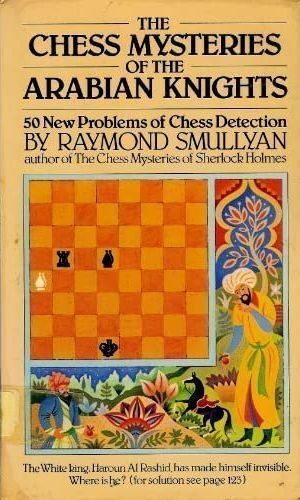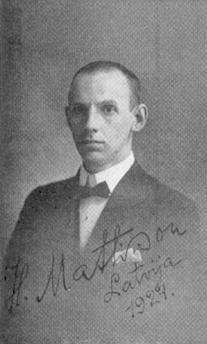A tête-à-tête with composer Steffen S. Nielsen
See Part I and Part II
We finally reach the crème de la crème of this entire write up where Steffen speaks his mind and provides in-depth answers to all of the author's questions! Detailed footnotes follow some of the answers. Go through them carefully and get a glimpse of the workings of a top chess composer's mind.

The great composer Steffen S. Nielsen
Satanick Mukhuty (SM): I would like to start from the very beginning. How and when did you get into chess compositions? Who taught you the basics?
Steffen Nielsen (SN): I began in a chess club when I was 13. My tutor was mainly Hans Christian Andersen (yes, that is his real name). He owned the book Chess Mysteries of the Arabian Knights by Raymond Smullyan so we solved these, luckily fairly simple, retro problems together. That may well have been where my interest for chess curiosities started.

The Chess Mysteries of the Arabian Knights was the first book Steffen read with his coach that instilled in him a perennial love for chess curiosities

Raymond Smullyan was an American Mathematician/Logician who helped popularize the genre of Retrograde Analysis in chess problems through his two excellent books - The Chess Mysteries of Sherlock Holmes and The Chess Mysteries of the Arabian Knights
SM: It would be great if you could also tell us why you have taken up chess composition? Chess for most people means playing and competing in tournaments with other players. So I ask this question to you because the world needs to know a little more about the motivation behind composing studies and problems.
SN: In my twenties and early thirties I played a lot of chess. My rating peaked at 2244 in 2007. During that period I composed some amateurish problems and mini-studies, which were published only in club magazines. Then I became a family man. I started playing less and spent more time composing. My first study was submitted to a tournament by the British Chess Problem Society to celebrate the London 2012 Olympics. Its creation was a few years underway, but it did not win any honors. Then later that year, I won the Timman 60 JT and I was hooked for good.
 Learn about one of the greatest geniuses in the history of chess! Paul Morphy's career (1837-1884) lasted only a few years and yet he managed to defeat the best chess players of his time.
Learn about one of the greatest geniuses in the history of chess! Paul Morphy's career (1837-1884) lasted only a few years and yet he managed to defeat the best chess players of his time.
The Timman Jubilee Tourney that was held in honour of the legendary player and study composer Jan Timman who turned 60 in 2012 proved to be the turning point in Steffen's career as a composer | Photo: Wikipedia
SM: Tell us a bit about your professional life. You are a journalist as far as I know. How do you balance your job and passion for chess?
SN: Compared to OTB chess, composing has a great advantage that you can spend 5 minutes here and 15 minutes there. I use my phone a lot in public transport, during breaks at work (I sincerely hope that my employer is not a reader of ChessBase India!), and whenever my kids leave me a couple of minutes of silence. I must also say, that I don't know where my studies would have been today without my loving and generous wife.

Steffen with his family in the outskirts of Copenhagen - his wife Eva, son Filip and daughter Ida | Photo: S. Nielsen
SM: You won the bronze medal in the studies section of the last WCCI. It must have been a very special feeling for you. How does it feel to be one of the best in the world?
SN: The judging of studies is such a subjective matter. I see my colleague composers like Costeff and Pervakov create ambitious works that I would never be able to do. Oleg Pervakov is the greatest composer now and, in my opinion, of all time. But yes, when I hit my peak I am definitely up there among the best. That is difficult to grasp because as a regular chess player I've never had any real talent (or work ethic). I've never beaten or drawn a GM and I've only won against an IM once. And I really sucked at practical endgames, never entering them unless I was a couple of pawns up. But all of a sudden I've found my niche.
SM: Who are the composers who have influenced you the most and why? Please do quote a study (or problem) if you like!
SN: This is a difficult question. Until ten years ago I had probably only heard of Kasparyan and knew only his super fork study with 7.g4 as well as the Reti (Kh8-g7) and Saavedra studies. So my style does not originate from any one composer. Recently I've spent a lot of time playing through the work of my predecessors and while I gained admiration for, among others, Mattison's studies, I still see no clear source of inspiration. If anything my studies is more inspired by problem themes like Novotny, unpin, crosschecks, and other line effects. My style is highly visual. Critics may even say superficial.

Hermann Mattison (1894 - 1932) | Source: arves.org
Editor's Note: Among his predecessors, Hermann Mattison is someone whom Steffen especially admires. Mattison was a strong Soviet player and during the 1920s arguably one of the best study composers. Tartakower even referred to him as the "World Champion of Study Composers". He didn't compose many studies however, his total output being less than ahundred. But remarkably almost all his productions are of extremely high quality. The following is an impressive example
White's winning plan consists of promoting the h-pawn but this requires some daring finesse. It must start with 1.Rb8+ for 1.h7 immediately is a blunder in view of 1...Rf1+! 1...Kxc2 2.h7 Rh1 this is the best way to stop the pawn, 2...Bxg4+ 3.Kg2 Bf3+ 4.Kxf3 Rh1 5.h8=Q Rxh8 6.Rxh8 a4 7.Ra8 Kb3 8.Ke2 for instance, is a straightforward win for White. 3.Rb2+! an important move, 3.h8=Q? is an error due to 3...Bxg4+ 4.Kxg4 Rxh8 5.Rxh8 a4 6.Ra8 Kb3 which leads to a draw as wK isn't in time to catch Black's a-pawn. 3...Kc1 and now comes the showstopper 4.Rh2!! Black is forced to take 4...Rxh2 and next 5.Kg3 wins. There's no way to prevent h8=Q anymore!
Mattison has such flamboyant surprises in store even in a short study of length five!
SM: I have to ask you about the study that won the first prize in Chessstar 2018 and also made into the FIDE Albums scoring 11.25 points. You posted this incredible work on Facebook where I saw it even baffled many strong GMs. Can you give us some insights on how you came up with such a deliciously complex masterpiece? How much time did it take you to compose this?
We are obviously talking about this multilayered masterpiece - study no.4 previously explained. Let's now hear about it from the composer himself!
SN: This is bound to turn into a lengthy explanation. The study from Chessstar makes me very happy because it was a product of a scheme that I had been working on (and off) for more than a year. This is a good example of my composing method. The traditional and proven composing method consists of finding a good idea and proceeding to build a fitting introduction. The end product is a study slowly building up to a dramatic climax. My method is often different. I too begin with an idea, as every study should. But my idea is typically a tactic rather than a position. The tactic may appear in the beginning, the middle, or the end of the final study. It may be played by either Black or White. It may be shifted, mirrored or changed from diagonals to ranks and files. For this study, my idea, indistinct at first, was the following. One side, here White, gives check (3.Ke5+). Black interposes a piece (3...e3). That piece is captured with a check (4.Bxe3+), but the checking piece has now entered a pin line (e1-e5). Therefore Black is able to interpose a second piece (4...Rf4), which this time cannot be captured. Somewhere during the process I realized that the second interposing move (4...Rf4) ought to be a quiet move and not the mate I had originally planned. Also somewhere along the line, I realized that this idea had the most effect if White's second checking move (4.Bxe3+) opened a line (a1-e1) resulting in a dramatic confrontation of two line-pieces. Such a confrontation creates an open-ended suspense that I really treasure. The climax occurs on the 4th move out of 18.
Such an early climax goes against all conventions of studies (and other aspects of life, I'm sure). And it puts the composer in a pickle. What if the solution peters out in an uneventful finale? I am afraid to admit so, but this is where the computer engine enters the story. The Danish writer Adam Oehlenschläger wrote of "oranges dropping into one's turban" as a metaphor for luck. Hard hopeful work and a lot of luck are needed. Here I found the additional quiet move 5.Qb2 and the double rook sac 9.Rg7. And at a point where I was already quite happy with my work, my engine friend suggested the final trick 14.Bd4. I am thrilled that GMs like this study. But something made me happier. The puzzled questions of fellow composers: "What was your original idea for this study? Was it 4...Rf4? Surely 9.Rg7+ then? Or perhaps 14.Bd4?" To this date, my three best studies (this one and Schach 2018 + Lepkiy 130 MT) were all built in this chaotic manner.
 This DVD allows you to learn from the example of one of the best players in the history of chess and from the explanations of the authors (Pelletier, Marin, Müller and Reeh) how to successfully organise your games strategically, consequently how to keep y
This DVD allows you to learn from the example of one of the best players in the history of chess and from the explanations of the authors (Pelletier, Marin, Müller and Reeh) how to successfully organise your games strategically, consequently how to keep y
[Indeed, this study had not one but three climaxes: 4...Rf4, 9.Rg7, and 14.Bd4. The study was aptly called "alien" by Martin Minski. The most singular output of Steffen's uncommon chaotic method perhaps?]

Steffen lecturing on this very method of "Chaotic Composing" at the World Congress of Chess Composition in Vilnius 2019 | Photo: S. Nielsen
SM: What are the things that according to you make a chess problem and/or a study great?
SN: I am greatly impressed by deep problems and studies, like the masterpieces of Costeff and Pervakov. But I am not a deep composer. I am very much aiming for effect. If someone is clicking through a pgn of my study and suddenly comes to a halt because a move comes out of nowhere, I've caused the effect that I try to achieve. I think 4...Rf4 does that in the study above. I want to invent new tactics and effects. This is totally possible, by the way. We must remember that at some point someone first discovered the smothered mate, which is now part of every chess kid's weaponry. I am trying to expand this weaponry of chess combinations. My latest obsessions are unpin Novotnys and Plachuttas: A White piece arrives at an intersection square of two linear pieces simultaneously unpinning a Black piece on a third line. At a gathering of study composers, Martin Minski presented one of his studies and I remember Yochanan Afek saying, "I did not think such a thing was possible in the game of chess." This is also something I am aiming for. I want to perplex chess players who have "seen it all".
Editor's Note: To just elucidate a little more on what Steffen means by "aiming for effect" and "deep composition" we present two studies of very contrasting type by Emilian Dobrescu. The first study is one of Steffen's favourites and is very much in line with his own style. The second one is a good illustration of "depth".
The play in this study is wonderfully delightful but each individual move in itself isn't really hard to understand. The struggle revolves around Black's pawn on a2 which is a move away from promoting and in the solution White sacrifices as many as three knights to neutralize it. Going over the replayer below makes it all clear.
The above study is amusing not because it has great depth but rather because it has a nice "flow". The pace and the clarity with which one move follows the next in the solution is what lends it its beguiling touch. Our next example (again by Dobrescu) is not as spectacular, however it indeed is what one would describe as "deep". It features one move in particular (an intermezzo) the logic behind which, as we will see, is not all that straightforward to discern.
This example, by the way, is taken from Jon Levitt and David Friedgood's excellent text "The Secrets of Spectacular Chess", where they delve into aesthetic elements of chess like flow and depth in great detail. Incidentally, this study was also posed in the British Solving Championship 1993 final where curiously three GMs - John Nunn, Jonathan Mestel, and Colin McNab - failed to solve it in the allotted time limit of 35 minutes!
The solution begins with 1.d7! but things get tricky after Black's first move 1...Rf4! itself. Of course, 1...Kxb6 isn't a testing move because White wins easily in that case with 2.Ke8 Rxd7 3.Kxd7. But after 1...Rf4, the win isn't that simple. 2.Kc8 looks like a decent logical attempt but after 2...Rxd4 3.b7 Rc4+ 4.Kb8 Rb4! Black holds, 5... Rxb7+ 6.Kc8 Rb8+ 7.Kxb8 is a stalemate. 2. Kc7 Rxd4 3.b7 Rxd7+ is not going anywhere either. The key move here is actually 2.d5! - there's nothing stunning about this move but the point behind it is really well-hidden and it's the key to converting this endgame.
So why do you think 2.d5! is such an important move?
Well, the logic becomes clear with subsequent play. 3...Rxd5 4.b7 Rc5+ 5.Kb8 and now we see the point: the black rook can't go to the b-file anymore as the b5 square is covered by wPa4! 2.d5! was therefore a decoy in disguise. Simple yet hard to grasp.
Thanks to 2.d5! the black rook is on the fifth rank now and ...Rb5 isn't possible.
The play continues 6.Ka8 Rxd7 7.b8=N+! (7.b8=Q?? Rd8 8.Qxd8 stalemate) 7...Kb6 8.Nxd7+ Kc6 9.Ne5+ Kc5 10.Nd3+ Kc4 11.Nb2+ Kb3 12.Ka7 Kxb2 13.Ka6 and White wins!
SM: I have seen you taking interest in genres other than studies. You have composed a couple of fairy problems as well. Do you consider specializing in a new field in the future?
SN: Apart from studies, I am especially fond of helpmates, and I will surely compose more helpmates in the future. But to be honest there are so many great composers in the other genres. Amazing logical and mathematical minds. I am in awe when I think about what, for instance, Michel Caillaud has accomplished across genres. When I see the complex creations these minds are able to make work, I am not sure a few line effects from me will make an impact in, for instance, helpmates.
 Nigel Short takes us on an electrifying journey through a very rich chess career, which saw him beat no less than twelve world champions. His experience in tournaments and matches all over the world – Short has visited a total of 89 countries – can be seen in the narratives that precede the games which he annotates with humour and instructive insights.
Nigel Short takes us on an electrifying journey through a very rich chess career, which saw him beat no less than twelve world champions. His experience in tournaments and matches all over the world – Short has visited a total of 89 countries – can be seen in the narratives that precede the games which he annotates with humour and instructive insights.
Michel Caillaud | Photo: Wikipedia
The Frenchman Michel Caillaud is a prodigious phenomenon in the world of composing. He became a Grandmaster of chess composition in 1993 at the age of 36 which was a record at the time. Caillaud composes literally everything across orthodox and unorthodox genres with equal mastery, and is also a terrific solver who won the World Solving Championship twice in 1987 and 2000.
SM: You have composed a good number of masterpieces with your good friend Martin Minski. In over the board chess coaches and seconds collaborate with players. How does the process of collaboration in composing work in general?

Martin Minski | Photo: M. Minski
[Martin Minski of Germany is currently the Vice World Champion in study composing. He is a good friend of Steffen and has authored several masterpieces with him.]
SN: My collaboration with Martin takes place ninety-nine percent online. We send back versions on chat and email. Luckily we agree on the basics, so whenever we disagree it is about minor details. The main trick is to remain open to ideas of the other person and not be too dogmatic. If you set out to make sure that all pieces must move during the solution, or that the final product must have a specific form, creativity is hampered. Pragmatism is the greatest asset of our collaboration in my view. Martin has great ideas but also a great feeling for what is possible and what is not. I spend weeks on studies that I fail to make work, and Martin will either spent an hour convincing himself (and eventually me) that it cannot be done or just as often he will spend one day making it work!

Although 99% of the Nielsen-Minski magic takes place online, the duo often meet in person as well! | Photo: Martin Minski
This article would certainly remain incomplete without quoting a couple of amazing Nielsen-Minski coproductions. So here goes our pick!
A crazy tactical study where White starts off with an audacious queen sacrifice and then goes for some surreal underpromotions to ensure stalemate avoidance! 1.Qh4+ Nxh4 2.Bb1 White too goes after Black's queen 2...Kg6 3.c7 and now there are two continuations
(a) 3...Qe4 in this case White goes 4.cxd8R!! - the first underpromotion. Note that 4.Bxe4 is out of question as Black has 5.Nf5# and 4.cxd8=Q? too is a mistake because of 4...Nf5+ 5.Qxh8 Qh4+ 6.Qxh4 pin-stalemate! So the mainline continues 4...Rh6 5.Rh8 Rxh8 6.f8=R! (and not 6...d8=R? which fails to 6...Rh6!) 6...Nf5+ 7.Rxh8 Qh4+ 8.Rxh4 and White wins, no stalemate this time!
(b) The second possibility is 3...Qd3 and in this case we have a similar variation but with a slight thematic change: 4.cxd8=R!! Rh6 5.Rh8 Rxh8 6.d8=R! (important to not play 6.f8=R? instead, in which case Black equalizes with 6...Rh6!) 6...Nf5+ 7.Rxh8 Qg3+ 8.Kh1 Qh4+ 9.Rxh4 winning, and once again the underpromotion ensures that stalemate is avoided. 4.cxd8=Q? doesn't work obviously because of 4...Nf5+ 5.Qxh8 Qg3+ 6.Kh1 Qh4+! 7.Qxh4 leading to the exactly same pin-stalemate. A lively study with harmonious echo of ideas in two mainlines!
This next study is very much the same in spirit to the first one but only more intense. The solution begins with 1.Bf1, note that 1.Qxa4 isn't possible because of 1...Qf3#, Black is down two pawns but can create threats along the weak a8-h1 diagonal. 1...Nf4 2.Bg2, and now the play bifurcates into two distinct continuations:
(a) 2...Qe2! Black intends to deflect the white light squared bishop from the a8-h1 diagonal 3.Bb7 Qa6!! deflection! 4.Bxa6 isn't possible because of 4...Bc6+ followed by mate. So White counters with a queen sacrifice of its own: 4.Qd5!! blocking the diagonal!
Both sides compete to give their queens away!
The line further continues 4...Nxd5 5.Bxa6 Bc6 6.Bb5 Bb7 7.Bxd4 Nc7+ (does Black regain material here? Well, not exactly...) 8.Kg1 Nxb5 9.Bc5 and it all ends with a striking final position where the black knight is unexpectedly dominated.
On b5 the luckless black knight is caught between the proverbial scylla and charybdis, and that is how White manages to keep the material advantage intact. Black doesn't really win an extra piece with 8...Nxb5 as the very next move 9.Bc5 leaves the black knight completely trapped. Now simply 10.c4 followed by the capture of the immured knight will happen next and that will leave White with three extra pawns and a completely winning position!
And do not miss the charming rectangular round-trip that White's light-squared bishop carries out in this variation. With 5.Bxa6 the bishop returns to its initial square via the a6-f1-g2-b7-a6 circuit. This is what renders the study visually even richer. The judge John Nunn had rightly pointed that such maneuvers are common in helpmates but quite a rarity in studies.
(b) The second variation is even more direct with Black sacrificing the queen right away, White however defends analogously: 2...Qh3!! 3.Qd5!! Steffen and Martin are from a different planet where chess players are very eager to give away their queens!
A perfect echo of variation (a). The cluster a6-b7 mirrors h3-g2 in the other corner of the board!
The rest of the moves are simple enough: 3...exd5 4.Bxh3 Nxh3 5.b7 and wins! A perfect geometric garnet! Replay it in full below with all the analysis:
SM: My final question: Do you have a dream study? An idea that you would really want to achieve some day, that perhaps would be hailed as your magnum opus by posterity?
SN: I've thought about this for some time, actually. I have a dream about the perfect king hunt study. Like Kasparov - Topalov, Wijk Aan Zee 1999 or Averbakh - Kotov, Zurich 1953 (30...Qxh3!!) just much crazier. It must start off with a queen sacrifice in a realistic middle game position. The Black king is forced deep into White's position. But there is no immediate mate. Instead White must make a quiet move allowing Black pieces to come to the rescue, giving back some of his material surpluses. After several twists and turns, we now have an endgame with equal material where White decides matters with a deep quiet move... For now, I am nowhere near succeeding in this. Which is why it is a dream study, I guess!
Links


































